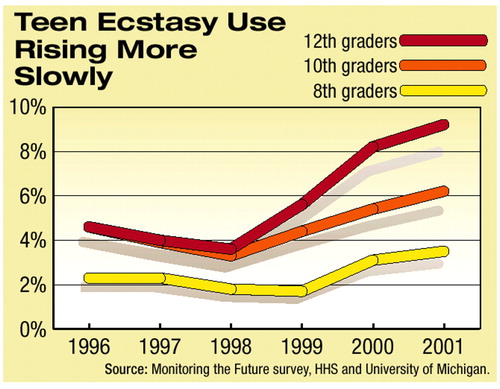More Teens Using Ecstasy, But Increase Begins to Slow
 Despite evidence that Ecstasy can kill, teen use of the “club drug” is still on the rise, according to the Department of Health and Human Services’ Monitoring the Future study.
Despite evidence that Ecstasy can kill, teen use of the “club drug” is still on the rise, according to the Department of Health and Human Services’ Monitoring the Future study.
The study, which included self-reported data from a representative sample of 44,000 students in grades eight, 10, and 12 in more than 400 schools across the nation, tracks major trends in the use of illicit drugs such as LSD, cocaine, heroin, and marijuana. In addition, researchers gather information on the smoking habits of youth. “Use” is defined as having taken the drug at least once in the past year.
The University of Michigan’s Institute of Research, which conducts the study during each academic year, found that in 2001, 3.5 percent of eighth graders, 6.2 percent of 10th graders, and 9.2 percent of 12th graders had taken Ecstasy in the past year.
These numbers pose a striking contrast to data from 1998, when 1.8 percent of eighth graders and 3.3 and 3.6 percent of teens in 10th and 12th grades, respectively, used the drug. Although these percentages almost tripled between 1998 and 2000, the increase has been less drastic in the past year, according to study data.
Researchers postulate that perhaps the usage rates aren’t growing as quickly because more teens are aware of the dangerous effects of the drug, which, according to research sponsored by the National Institute on Drug Abuse, can cause brain damage and even death.
Researchers asked 12th graders about their perceptions of risk for Ecstasy use, and those who deemed Ecstasy experimentation “a great risk” jumped by 8 percent last year, from 38 percent in 2000 to 46 percent in 2001.
Ecstasy was also easier to obtain in 2001 than in years past. While 40 percent of 12th graders said that they could get Ecstasy “fairly” or “very” easily in 1999, 62 percent said the same in 2001.
Lloyd Johnston, Ph.D., is the principal investigator of the Monitoring the Future study and the Distinguished Research Scientist at the University of Michigan. He told Psychiatric News that the increased use of Ecstasy may be due to its reaching communities that haven’t encountered it before. “In these communities,” he said, “there will be new users recruited even if use already has begun to decline in other communities that have had Ecstasy available for some time. [The decline in those communities is] due to the fact that young people generally are beginning to see it as more dangerous.”
Although Ecstasy use is still on the rise, usage rates during the past year for other illicit drugs dropped in 2001, according to the Monitoring the Future study:
• Tenth graders are using crack and powder cocaine less. Use declined from 4.9 percent in 1999 to 3.6 percent in 2001.
• LSD use is also on the decline. Tenth graders, once again, showed the most significant decreases: 6.9 percent had used the drug in 1996, but only 4.1 percent did so in 2001. Johnston speculated that the drop was due to the rising popularity of Ecstasy.
• Although the decline in inhalant use reached statistical significance only for 12th graders, inhalant use, including solvents and aerosols, dropped for all three age groups. For 12th graders, use dropped from 5.9 percent in 2000 to 4.5 percent in 2001. Although Johnson said he is hesitant to attribute the decline in the use of certain drugs to antidrug campaigns, the exception he was willing to make was for the use of inhalants. “We think that the active efforts of the Partnership for a Drug-Free America and other organizations to get the word out about the dangers of inhalants have paid off,” he said. He noted that in 1996 adolescents surveyed around the time of an ad campaign warning about the dangers of inhalant use perceived that the risk of such behavior was greater than did adolescents surveyed at other times.
• For each grade level on the aggregate, the percentage who used any illicit drug during the prior year was lower than peak usage found several years ago. However, only the percentages for eighth graders are notable. Usage rates for that group dropped from 23.6 percent in 1996 to 19.5 percent in 2000 and 2001. The other two grades did not show any change between 2000 and 2001 either. The plateau is due to the fact that usage rates for marijuana, which is the most commonly used illicit drug, remained steady this year.
• For all student groups, marijuana use remained about the same in 2001 as in 2000. Rates were especially high for 12th graders, for whom peak usage occurred in 1997, when 38.5 percent of 12th graders used marijuana. In 2001 the usage rate was 37 percent.
• The percentage of teens who smoke cigarettes is declining. Between 1996 and 2001, smoking among eighth graders fell from 21 percent to 12 percent, and among 10th graders from 30 percent to 21 percent.
More information about the Monitoring the Future study can be obtained at www.monitoringthefuture.org. ▪



